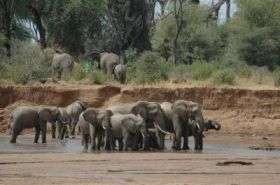Social standing influences elephant movement

When resources are scarce, who you know and where you're positioned on the social totem pole affects how far you'll go to search for food. At least that's the case with African elephants, according to a study led by ecologists at the University of California, Berkeley, who collaborated with researchers at Save the Elephants, a non-profit research organization based in Kenya, and at the University of Oxford in England.
An analysis of social dominance relationships and roaming patterns of free-ranging elephants in the Samburu and Buffalo Springs National Reserves in northern Kenya found that elephants led by older, more dominant matriarchs tromped significantly fewer miles to seek food than those a few rungs lower on the social ladder.
During the dry season, when water and vegetation were harder to come by, dominant groups traveled an average of 4-5 kilometers per day, about half the distance of subordinate groups that would trek 8-11 kilometers per day.
Additionally, dominant groups in the study were more likely to stick to the preferred central, protected areas of the park, where fewer humans and more water can be found.
"This work shows, for the first time, the role social factors play in the dispersal of elephants in an ecosystem," said lead author George Wittemyer, a post-doctoral researcher at UC Berkeley's College of Natural Resources and a National Science Foundation International Research Fellow. "The findings have significant policy implications for how elephant populations are managed."
The elephants in this study occupied an open park, but in many areas of Africa, significant tracts of land are being fenced off to keep the elephants away from agricultural communities where the pachyderms' propensity to raid crops have earned them the label of pests. For example, some 12,000 elephants are enclosed in a 7,000 square kilometer area of South Africa's Kruger National Park.
The fencing practice has generated a great deal of debate about how best to balance the needs of the elephants with those of local residents - many of whom are subsistence farmers in need of protecting their crops. But the questions currently focus on the impact of the elephants on the local vegetation.
"Elephants can feed on a wide range of vegetation, but if they can't move, they're more likely to focus on a particular species - such as a favorite tree - potentially removing it from a local area," said Wittemyer. "Being 'ecosystem engineers,' they are capable of changing wooded plains to complete grasslands. Elephants have huge space and resource needs, and are particularly impacted by land use changes. Fencing in these populations means blocking them from their normal behavior of dispersal and migration, and changing the dynamics of how they interact with their environment."
The new findings, published in the October issue of the journal Behavioral Ecology and Sociobiology, suggest that fencing can have other impacts not previously known on the social behavior of the elephants.
"What happens when elephant groups are forced into close contact with each other all the time" That's not yet clear," said Wittemyer. "Current elephant management plans do not yet consider the impact on social relationships."
Elephants are known for their complex social networks, with families of six to 12 individuals ruled by a matriarch. "They're one of the very few species that have a level of complexity in their social networks comparable to humans," said Wittemyer. "Studies have shown that elephants can distinguish more than 100 individuals just by their vocalization patterns."
The researchers individually recognize in northern Kenya over 900 elephants - including seven who were fitted with GPS collars. Over the course of nine years, they carefully observed elephant interaction, taking note of the telltale behavior of social dominance, such as the flaring of the ears, a tusk poke here or a trunk slap there, to determine rank.
Three of the GPS-collared elephants were from very dominant families, two were in the middle, and two were positioned low in the social hierarchy. Elephant groups averaged nine members and were each led by a matriarch. Out of the study population, 50 groups were the focus of this paper.
"Save the Elephants' advanced satellite tracking system is enabling us a unique and fascinating insight into the hourly movements of our study elephants," said Iain Douglas-Hamilton, study co-author and founder of Save the Elephants, which supported the radio-tracking of the elephant movements. "Our collars are now revealing how complex the relationship is between elephants' social structure and their environment."
Interestingly, the differences in movement among the various groups disappeared during the wet season, when food and water are readily available.
"When resources are plentiful, there is little competition, so there is no need for socially mediated differentiation in how space is used," said Wittemyer. "Dominant groups actually increase their movements in the wet season, exploring the region and interacting socially with other groups. Elephants love to move. It's when conditions are bad that they conserve energy by restricting their movement."
Source: University of California - Berkeley















